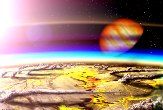To Find Alien Volcanic Eruptions, Look for Foul Gas

Astronomers may be able to detect volcanic eruptions on Earth-like alien planets, a new study suggests.
While these eruptions would have to be huge for telescopes to pick them up, researchers think they can do it by scanning the heavens for sulfur dioxide, a gas that volcanoes commonly spew out. [Image of a volcanic alien world.]
"Our first sniffs of volcanoes from an alien Earth might be pretty rank," study co-author Lisa Kaltenegger, of the Harvard-Smithsonian Center for Astrophysics in Cambridge, Mass., said in a statement. "Seeing a volcanic eruption on an exoplanet will show us similarities or differences among rocky worlds."
Characterizing alien worlds
To date, astronomers have discovered almost 500 alien planets orbiting distant stars. While continuing the search — with powerful new tools like NASA's Kepler space observatory, which was launched in March 2009 — scientists are also trying to learn what these faraway worlds are like.
Researchers cannot yet image the surfaces of exoplanets well, but they have been able to detect and study the atmospheres of a few alien gas giants, planets similar to Jupiter in size and composition.
These successes hint at a strategy for learning about rockier, Earth-like worlds. Since volcanic activity sends out fumes and various gases, eruptions on a rocky exoplanet could leave a telltale atmospheric signature, researchers say.
Sign up for the Live Science daily newsletter now
Get the world’s most fascinating discoveries delivered straight to your inbox.
To examine which volcanic gases might be detectable, Smithsonian astronomer Kaltenegger and her colleagues from Harvard University, Wade Henning and Dimitar Sasselov, developed a model for eruptions on an Earth-like exoplanet based on the present-day Earth. The model suggests that sulfur dioxide from a very large, explosive eruption could be measurable because large volumes of the compound are often produced and it is slow to wash out of the atmosphere.
Enormous eruption
The eruption would have to be gigantic for astronomers to detect it, the researchers say.
"You would need something truly earth-shaking, an eruption that dumped a lot of gases into the atmosphere," Kaltenegger said. "Using the James Webb Space Telescope, we could spot an eruption 10 to 100 times the size of Pinatubo for the closest stars."
The 1991 eruption of Mount Pinatubo in the Philippines spewed about 17 million tons of sulfur dioxide into the stratosphere, a layer of air six to 30 miles (10 to 48 km) above Earth's surface. The largest volcanic eruption in recorded history, the 1815 Tambora event, was about 10 times more powerful — just barely enough to be measured on a nearby planet by the James Webb instrument, an observatory envisioned as a next-generation Hubble telescope that is currently under construction and due to launch in 2014.
Such huge eruptions are infrequent on Earth, so astronomers might have to monitor many Earth-size exoplanets for years to catch one in the act. However, if alien worlds are more volcanically active than Earth, success could be more likely.
"A Tambora-sized eruption doesn't happen often here but could be more common on a younger planet, or a strongly tidally active planet — analogous to Io," said Henning, referring to one of Jupiter's moons. "Once you detected one eruption, you could keep watch for further ones, to learn if frequent eruptions are common on other planets."
To look for volcanic sulfur dioxide, astronomers would rely on a technique known as the secondary eclipse, which requires the exoplanet to cross behind its star as seen from Earth. By collecting light from the star and planet, then subtracting the light from the star while the planet is hidden, astronomers are left with the signal from the planet alone. They can search that signal for signs of particular chemical compounds.
The researchers say it should be possible to find signs of volcanism with the James Webb Space Telescope on Earth-like planets less than 30 light-years away.
The research will be detailed in an upcoming issue of the Astrophysical Journal.












